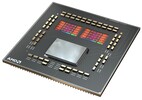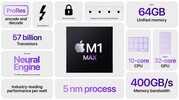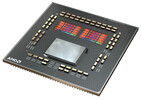AMD Ryzen 7 5700X vs Apple M1 Max vs AMD Ryzen 5 5600X
AMD Ryzen 7 5700X
► remove from comparison
The AMD Ryzen 7 5700X is a desktop processor with 8 cores and simultaneous multithreading (SMT), which means it can process 16 threads simultaneously. In April 2022, AMD presented the Ryzen 7 5700X, a new 8-core processor that is very similar to the AMD Ryzen 7 5800X. However, due to the lower TDP, there are no restrictions on the clock frequency. Nevertheless, the AMD Ryzen 7 5700X reaches up to 4.6 GHz in boost, which is only 100 MHz less than the AMD Ryzen 7 5800X. However, the base clock drops significantly to 3.4 GHz.
The performance of the AMD Ryzen 7 5700X is consistently excellent in all applications. The native 8-core can really show off its strengths, especially in multi-threaded applications, although the single-core performance has also been significantly improved compared to the older Zen 2 architecture.
The internal structure of the processor is similar to the AMD Ryzen 7 5800X. The CCX modules are also connected to each other via the I/O die, which we already know from Zen2. However, according to AMD, the Infinity Fabric should now achieve clock rates of up to 2 GHz, which in turn enables a RAM clock rate of 4,000 MHz without any loss of performance.
In terms of manufacturing processes, AMD also relies on TSCM for the 7nm production of the CPU cores in the Vermeer processors, although the I/O die is still supplied in 12 nm by Globalfoundries.
The AMD Ryzen 7 5700X is impressive in gaming thanks to the significantly improved IPC compared to Zen2. In terms of power consumption, the AMD Ryzen 7 5700X impresses with its low TDP of just 65 watts. This means that the processor can also be operated with a compact air cooler without any problems. The AMD Ryzen 7 5800X is operated with a TDP of 105 watts.
Apple M1 Max
► remove from comparison
The Apple M1 Max is a System on a Chip (SoC) from Apple that is found in the late 2021 MacBook Pro 14 and 16-inch models. It offers all 10 cores available in the chip divided in eight performance cores (P-cores with 600 - 3220 MHz) and two power-efficiency cores (E-cores with 600 - 2064 MHz). There is no Turbo Boost for single cores or short burst periods. The cores are similar to the cores in the Apple M1.
The big cores (codename Firestorm) offer 192 KB instruction cache, 128 KB data cache, and 24 MB shared L2 cache (up from 12 MB in the M1). The four efficiency cores (codename Icestorm) are a lot smaller and offer only 128 KB instruction cache, 64 KB data cache, and 4 MB shared cache. CPU and GPU can both use the 48 MB SLC (System Level Cache). The efficiency cores (E cluster) clock with 600 - 2064 MHz, the performance cores (P cluster) with 600 - 3228 MHz.
The unified memory (32 or 64 GB LPDDR5-6400) next to the chip is connected by a 512 bit memory controller (200 GB/s bandwidth) and can be used by the GPU and CPU. This is the main difference to the M1 Pro and the CPU performance is quite similar.
The biggest difference to the M1 Pro is the bigger integrated GPU with 24 or 32 cores (up from 16).
Furthermore, the SoC integrates a fast 16 core neural engine, a secure enclave (e.g., for encryption), a unified memory architecture, Thunderbolt 4 controller, an ISP, and media de- and encoders (including two ProRes engines).
The M1 Pro is manufactured in 5 nm at TSMC and integrates 57 billion transistors. The peak power consumption of the chip was advertised around 30W for CPU intensive tasks.
AMD Ryzen 5 5600X
► remove from comparison
The AMD Ryzen 5 5600X is a desktop processor with 6 SMT-enabled (12 threads) and based on the Zen 3 architecture. Launched in November 2020, it is the fastest 6-core Ryzen desktop processor. With a TDP of 65 watts, the Ryzen 5 5600X is the least energy-hungry model in the Zen 3 family to date.
The Ryzen 5 5600X is clocked at 3.7 GHz base clock and can be clocked up to 4.6 GHz with Precision Boost 2.
Performance
The average 5600X in our database is in the same league as the Ryzen 9 4900H and the Ryzen 7 6800HS, as far as multi-thread benchmark scores are concerned. While this isn't the fastest CPU money can buy, it still rips through most workloads with ease, as of mid 2022. Find out more in our full review.
Power consumption
This Ryzen 5 series chip has a default TDP (also known as the long-term power limit) of 65 W to be in line with most desktop processors.
The R5 5600X is built with TSMC's 7 nm process for average, as of early 2023, energy efficiency.
| Model | AMD Ryzen 7 5700X | Apple M1 Max | AMD Ryzen 5 5600X | ||||||||||||||||||||||||||||||||||||||||||||||||
| Codename | Vermeer (Zen 3) | Vermeer (Zen 3) | |||||||||||||||||||||||||||||||||||||||||||||||||
| Series | AMD Vermeer (Ryzen 5000) | Apple M1 | AMD Vermeer (Ryzen 5000) | ||||||||||||||||||||||||||||||||||||||||||||||||
| Series: Vermeer (Ryzen 5000) Vermeer (Zen 3) |
|
|
| ||||||||||||||||||||||||||||||||||||||||||||||||
| Clock | 3400 - 4600 MHz | 2060 - 3220 MHz | 3700 - 4600 MHz | ||||||||||||||||||||||||||||||||||||||||||||||||
| L1 Cache | 512 KB | 2.9 MB | 384 KB | ||||||||||||||||||||||||||||||||||||||||||||||||
| L2 Cache | 4 MB | 28 MB | 3 MB | ||||||||||||||||||||||||||||||||||||||||||||||||
| L3 Cache | 32 MB | 48 MB | 32 MB | ||||||||||||||||||||||||||||||||||||||||||||||||
| Cores / Threads | 8 / 16 | 10 / 10 | 6 / 12 | ||||||||||||||||||||||||||||||||||||||||||||||||
| TDP | 65 Watt | 65 Watt | |||||||||||||||||||||||||||||||||||||||||||||||||
| Technology | 7 nm | 5 nm | 7 nm | ||||||||||||||||||||||||||||||||||||||||||||||||
| Die Size | 2 x 74 sq. mm; I/O = 125 sq. mm mm2 | ||||||||||||||||||||||||||||||||||||||||||||||||||
| max. Temp. | 90 °C | 95 °C | |||||||||||||||||||||||||||||||||||||||||||||||||
| Socket | 1331 | AM4 | |||||||||||||||||||||||||||||||||||||||||||||||||
| Features | MMX(+), SSE, SSE2, SSE3, SSSE3, SSE4.1, SSE4.2, SSE4A, x86-64, AMD-V, AES, AVX, AVX2, FMA3, SHA, Precision Boost 2 | ARMv8 Instruction Set | DDR4-3200 RAM, PCIe 4, MMX (+), SSE, SSE2, SSE3, SSSE3, SSE4.1, SSE4.2, SSE4A, AES, AVX, AVX2, FMA3, SHA | ||||||||||||||||||||||||||||||||||||||||||||||||
| Architecture | x86 | ARM | x86 | ||||||||||||||||||||||||||||||||||||||||||||||||
| $299 U.S. | $299 U.S. | ||||||||||||||||||||||||||||||||||||||||||||||||||
| Announced | |||||||||||||||||||||||||||||||||||||||||||||||||||
| Manufacturer | www.amd.com | www.amd.com | |||||||||||||||||||||||||||||||||||||||||||||||||
| Transistors | 57000 Million | ||||||||||||||||||||||||||||||||||||||||||||||||||
| iGPU | Apple M1 Max 32-Core GPU |
Benchmarks
Average Benchmarks AMD Ryzen 7 5700X → 100% n=12
Average Benchmarks Apple M1 Max → 98% n=12
Average Benchmarks AMD Ryzen 5 5600X → 95% n=12
* Smaller numbers mean a higher performance
1 This benchmark is not used for the average calculation













